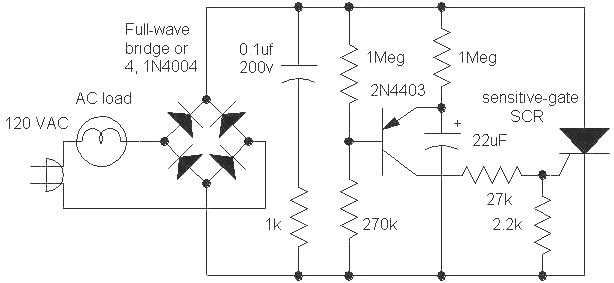

![]()
Here is a simple circuit for sequentially flashing Christmas light strings or other similar low-power lamps. The socket symbols may be single bulbs or sockets for lamp strings. The load must be capable of operating from DC since the SCRs rectify the line voltage. The SCRs must be sensitive-gate types and must be able to handle the load current and line voltage. The 1uF capacitors are non-polar film types. A fuse is indicated and a GFI type of outlet is recommended.

The circuit may be extended by repeating the pattern with the last neon lamp connecting back to the first through a capacitor. Although a quick breadboard was tested, this circuit is "experimental" and may require some tweaking for best performance. The flashing speed may be controlled by connecting a 100k ohm (or larger) potentiometer across the 10 uF capacitor and connecting the 1 meg resistors to the wiper. Make sure that the shaft is an insulated type. The 1 meg resistors may be lowered in value for faster flashing.
![]()
Here is an unusual flasher circuit for 120VAC loads. The circuit is similar to the two-transistor flasher seen in several circuits in techlib.com except that an SCR is used.

A little circuit trick is hiding in the selection of the 0.1uF capacitor in series with the 1k resistor. When the SCR is off, this capacitor smoothes the ripple from the bridge sufficiently for the transistor flasher circuitry to work properly but when the SCR turns on, the capacitor immediately discharges and will not provide enough current to keep the SCR on. Also,the capacity is low enough to leave quite a bit of ripple voltage causing the circuit to trigger near zero volts - a desirable feature!
Parts are not particularly critical:
| The 0.1uf capacitor should be a non-polar type with a voltage rating of at least 200 volts. The value is not critical but stay below about 1uF. | |
| The power handling device is a sensitive-gate SCR with a rated voltage of at least 200 volts and with a current rating sufficient to handle the expected load. Sensitive-gate SCRs typically have a gate trigger current near 200uA. | |
| The full-wave bridge may be made from four rectifier diodes rated for 200 volts or more and with a current rating well above the load current. | |
| The resistors all dissipate low power and ordinary carbon-film 1/4 watt types are fine. | |
| The PNP transistor may be just about any general-purpose type or a high voltage type may be selected to reduce the chances of zapping it while experimenting! Ordinarily, the transistor sees about 35 volts. | |
| The 22uF capacitor is a 50 volt or greater aluminum electrolytic or similar. | |
| The load sees AC voltage so most line-powered devices may be "flashed" with this circuit. | |
| Not shown are necessary fuses and line filtering. A power input module with everything built in is hard to beat. Low power loads will not generate much line noise but a fuse is always recommended. |
Here is how it works:
When power is first applied, the SCR is off and the 0.1uF capacitor charges to about 160 volts with several volts of ripple. The base voltage sees a divided-down version of this rippling voltage, near 35 volts. The 22uF capacitor begins charging through the 1meg resistor and the emitter voltage begins to rise towards the base voltage. When the capacitor voltage reaches about 35 volts and exceeds the base voltage (typically a low point in the ripple voltage), the transistor conducts causing the SCR to trigger. The triggering pulls the voltage on the base low and the transistor turns on hard because of the now-higher voltage on the emitter. The transistor stays on until the capacitor is discharged to the point that the gate current cannot keep the SCR triggered. The SCR turns off at the next voltage zero-crossing and the process repeats. Notice how the circuit tends to turn on and off near zero-crossings! The 1k in series with the 0.1uF capacitor protects the SCR from high discharge currents. (Most SCRs can handle the current surge without the resistor.)
The 1meg resistor connected to the 22uF may be varied to change the flash rate or the 22uF capacitor value may be changed. Do not drop the resistance much below 330k or the transistor may be susceptible to overvoltage damage in the event the SCR doesn't trigger. The length of the flash is set by the 27k resistor; a higher value gives longer on-time. The 2.2k is included to ensure that the SCR turns off and this value may be higher or eliminated if the SCR doesn't show a tendency to stay on. Some sensitive-gate SCRs become too sensitive for this circuit when they become warm, they actually require that current be pulled out of the gate to prevent triggering. A typical TO-92 type SCR will handle up to about 25 watt loads without a heating problem but for heavier loads choose a TO-202 or other power package. Heat-sinking may be required for heavy loads. If the circuit stays on after a few flashes, the SCR is self-triggering due to heating.
![]()